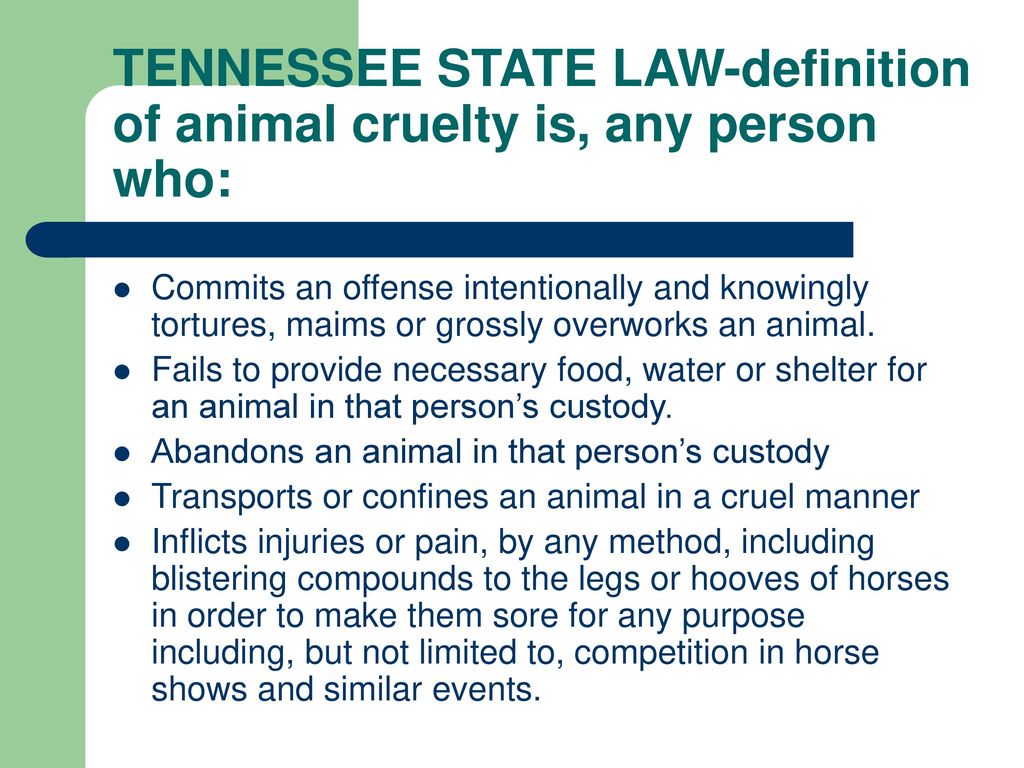Animal cruelty is a pressing issue that plagues many societies, prompting discussions around the legal repercussions for such behavior. One compelling question arises: Is animal cruelty a felony in Tennessee, and what are the potential penalties and sentencing structures that accompany these violations? Understanding the legal framework surrounding animal mistreatment is crucial for advocating for better protections for our voiceless companions.
In Tennessee, animal cruelty is taken seriously. The law encompasses a wide range of acts, from neglect and abandonment to direct violence against animals. Specifically, the definition outlined in legislation indicates that any person who, intentionally or knowingly, subjects an animal to severe mistreatment or suffering shall be considered in violation of the law. This reflects a growing acknowledgment that animals are sentient beings deserving of protection, and highlights society’s ethical responsibility towards them.
Under Tennessee law, animal cruelty is categorized primarily as a Class A misdemeanor for the first offense. This classification could involve penalties including a maximum of 11 months and 29 days in jail, a fine up to $2,500, or both. However, subsequent offenses can escalate the severity of the legal consequences significantly. For individuals with prior convictions related to animal cruelty, the charge escalates to a Class E felony. This broader classification is indicative of an overarching commitment to combating repeated acts of cruelty, thereby catalyzing a more stringent response from the judicial system.
It is imperative to consider the range of sentences associated with these classifications. For Class E felonies, the consequences become more severe. Offenders may face a prison sentence ranging from one to six years. Additionally, fines can be imposed at significantly higher levels, reaching upwards of $3,000. This escalation creates a deterrent effect, highlighting that the state regards animal cruelty not merely as a trivial offense, but as a serious societal concern meriting stringent scrutiny and repercussions.
Yet, the legal landscape does not merely stop at punitive measures. Community service requirements, counseling, or educational programs aimed at fostering empathetic treatment of animals can also be mandated by the court. This reflects a holistic approach, targeting not just the behavior during sentencing, but also striving to rehabilitate offenders and preventing future occurrences of cruelty.
Challenges arise when scrutinizing the enforcement and application of these laws. While the letters of the law may appear robust, the reality often diverges. Many instances of animal cruelty go unreported or are not prosecuted effectively due to a myriad of factors including a lack of resources, public awareness, or even apathy toward animal rights. Law enforcement agencies may not always prioritize animal welfare cases, resulting in a gap between the existence of legislation and its practical enforcement.
Moreover, the evidential burden can be daunting. Animal cruelty cases often rely heavily on witness testimony, expert veterinary opinions, and sometimes, forensic evidence. Communities face hurdles when it comes to gathering substantiated evidence that would stand in court, as many victims—animals—cannot vocalize their suffering. This silence presents a unique challenge for advocates attempting to secure justice for abused animals.
As awareness grows about the significance of animal rights, various organizations are working diligently to address these very challenges. Advocacy groups are pressing for more comprehensive measures: enhanced training for law enforcement on recognizing and handling animal cruelty, greater community outreach efforts to educate the public on their reporting responsibilities, and initiatives aimed at fostering a culture of empathy and respect toward all living beings.
Beneath the legal implications, there exists a moral dialogue. Society must grapple with the ethical ramifications of animal treatment and how legislation reflects collective values. Do we, as a society, genuinely believe that protecting animals is of paramount importance? Many argue that a society is measured not only by how it treats its most powerful but also, crucially, by how it cares for its most vulnerable members, including animals.
Furthermore, there’s the question of rehabilitation versus punishment. Some advocate for diversion programs that permit offenders to engage with animals in a therapeutic context, aiming to foster empathy and understanding. Does punitive action alone deter future offenses, or could a shift toward rehabilitation offer a more sustainable solution? Exploring these aspects continues to enrich the dialogue surrounding animal welfare and legal responses.
In conclusion, Tennessee’s legal framework surrounding animal cruelty is multifaceted and hinges on both punitive measures and societal perspectives. While the state enforces severe penalties for animal cruelty, consistent enforcement, awareness, and community engagement remain crucial for the efficacy of these laws. The challenge lies not only in defining cruelty but in transforming societal attitudes toward animals, ensuring our legal system reflects the compassion that is increasingly demanded in contemporary discourse. As discussions progress, the hope is for a future where our laws not only punish cruelty but fundamentally embody an ethos of respect for all living beings.








